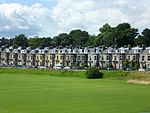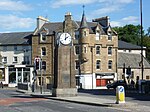Edinburgh North and Leith (UK Parliament constituency)

Edinburgh North and Leith is a constituency of the House of Commons of the Parliament of the United Kingdom (at Westminster), first used in the 1997 general election. It elects one Member of Parliament (MP) by the first past the post system of election. In 1999, a Scottish Parliament constituency was created with the same name and boundaries. See Edinburgh North and Leith (Scottish Parliament constituency). The boundaries of the Westminster constituency were altered, however, in 2005, and the Scottish Parliament constituency retained the older boundaries until 2011. Since then, the seat has mainly been split between the Edinburgh Northern and Leith and Edinburgh Central constituencies at Holyrood, with a small area also located in Edinburgh Western. In the 2014 Scottish independence referendum, the constituency returned an above average No vote; 60% opted for Scotland to stay in the United Kingdom, while 40% preferred Scotland to become an independent country. In the 2016 referendum to leave the European Union, the constituency voted remain by 78.2%. This was the seventh highest support for remain for a constituency.
Excerpt from the Wikipedia article Edinburgh North and Leith (UK Parliament constituency) (License: CC BY-SA 3.0, Authors, Images).Edinburgh North and Leith (UK Parliament constituency)
Cemetery Road, City of Edinburgh Stockbridge/Inverleith
Geographical coordinates (GPS) Address Nearby Places Show on map
Geographical coordinates (GPS)
| Latitude | Longitude |
|---|---|
| N 55.969166666667 ° | E -3.1997222222222 ° |
Address
Welcome to Warriston Cemetery
Cemetery Road
EH3 5NB City of Edinburgh, Stockbridge/Inverleith
Scotland, United Kingdom
Open on Google Maps







